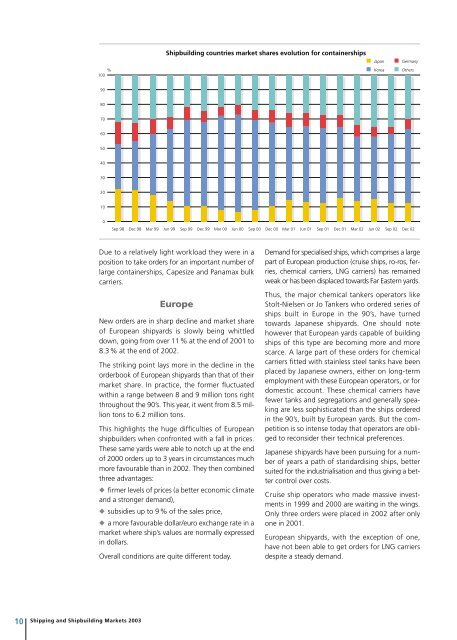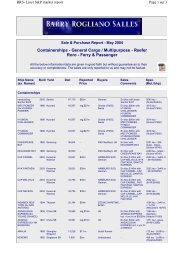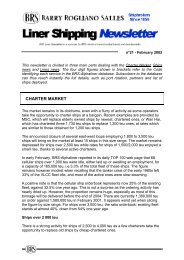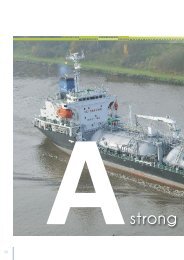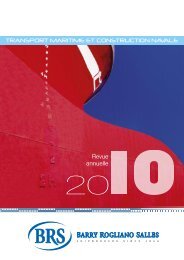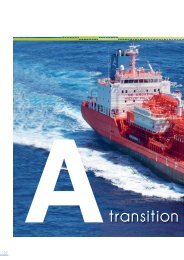RA BRS 2003 GB >pdf
RA BRS 2003 GB >pdf
RA BRS 2003 GB >pdf
Create successful ePaper yourself
Turn your PDF publications into a flip-book with our unique Google optimized e-Paper software.
10<br />
%<br />
100<br />
Shipping and Shipbuilding Markets <strong>2003</strong><br />
90<br />
80<br />
70<br />
60<br />
50<br />
40<br />
30<br />
20<br />
10<br />
0<br />
Due to a relatively light workload they were in a<br />
position to take orders for an important number of<br />
large containerships, Capesize and Panamax bulk<br />
carriers.<br />
Europe<br />
New orders are in sharp decline and market share<br />
of European shipyards is slowly being whittled<br />
down, going from over 11 % at the end of 2001 to<br />
8.3 % at the end of 2002.<br />
The striking point lays more in the decline in the<br />
orderbook of European shipyards than that of their<br />
market share. In practice, the former fluctuated<br />
within a range between 8 and 9 million tons right<br />
throughout the 90’s. This year, it went from 8.5 million<br />
tons to 6.2 million tons.<br />
This highlights the huge difficulties of European<br />
shipbuilders when confronted with a fall in prices.<br />
These same yards were able to notch up at the end<br />
of 2000 orders up to 3 years in circumstances much<br />
more favourable than in 2002. They then combined<br />
three advantages:<br />
◆ firmer levels of prices (a better economic climate<br />
and a stronger demand),<br />
◆ subsidies up to 9 % of the sales price,<br />
◆ a more favourable dollar/euro exchange rate in a<br />
market where ship’s values are normally expressed<br />
in dollars.<br />
Overall conditions are quite different today.<br />
Shipbuilding countries market shares evolution for containerships<br />
Japan<br />
Korea<br />
Germany<br />
Others<br />
Sep 98 Dec 98 Mar 99 Jun 99 Sep 99 Dec 99 Mar 00 Jun 00 Sep 00 Dec 00 Mar 01 Jun 01 Sep 01<br />
Dec 01 Mar 02 Jun 02 Sep 02 Dec 02<br />
Demand for specialised ships, which comprises a large<br />
part of European production (cruise ships, ro-ros, ferries,<br />
chemical carriers, LNG carriers) has remained<br />
weak or has been displaced towards Far Eastern yards.<br />
Thus, the major chemical tankers operators like<br />
Stolt-Nielsen or Jo Tankers who ordered series of<br />
ships built in Europe in the 90’s, have turned<br />
towards Japanese shipyards. One should note<br />
however that European yards capable of building<br />
ships of this type are becoming more and more<br />
scarce. A large part of these orders for chemical<br />
carriers fitted with stainless steel tanks have been<br />
placed by Japanese owners, either on long-term<br />
employment with these European operators, or for<br />
domestic account. These chemical carriers have<br />
fewer tanks and segregations and generally speaking<br />
are less sophisticated than the ships ordered<br />
in the 90’s, built by European yards. But the competition<br />
is so intense today that operators are obliged<br />
to reconsider their technical preferences.<br />
Japanese shipyards have been pursuing for a number<br />
of years a path of standardising ships, better<br />
suited for the industrialisation and thus giving a better<br />
control over costs.<br />
Cruise ship operators who made massive investments<br />
in 1999 and 2000 are waiting in the wings.<br />
Only three orders were placed in 2002 after only<br />
one in 2001.<br />
European shipyards, with the exception of one,<br />
have not been able to get orders for LNG carriers<br />
despite a steady demand.


